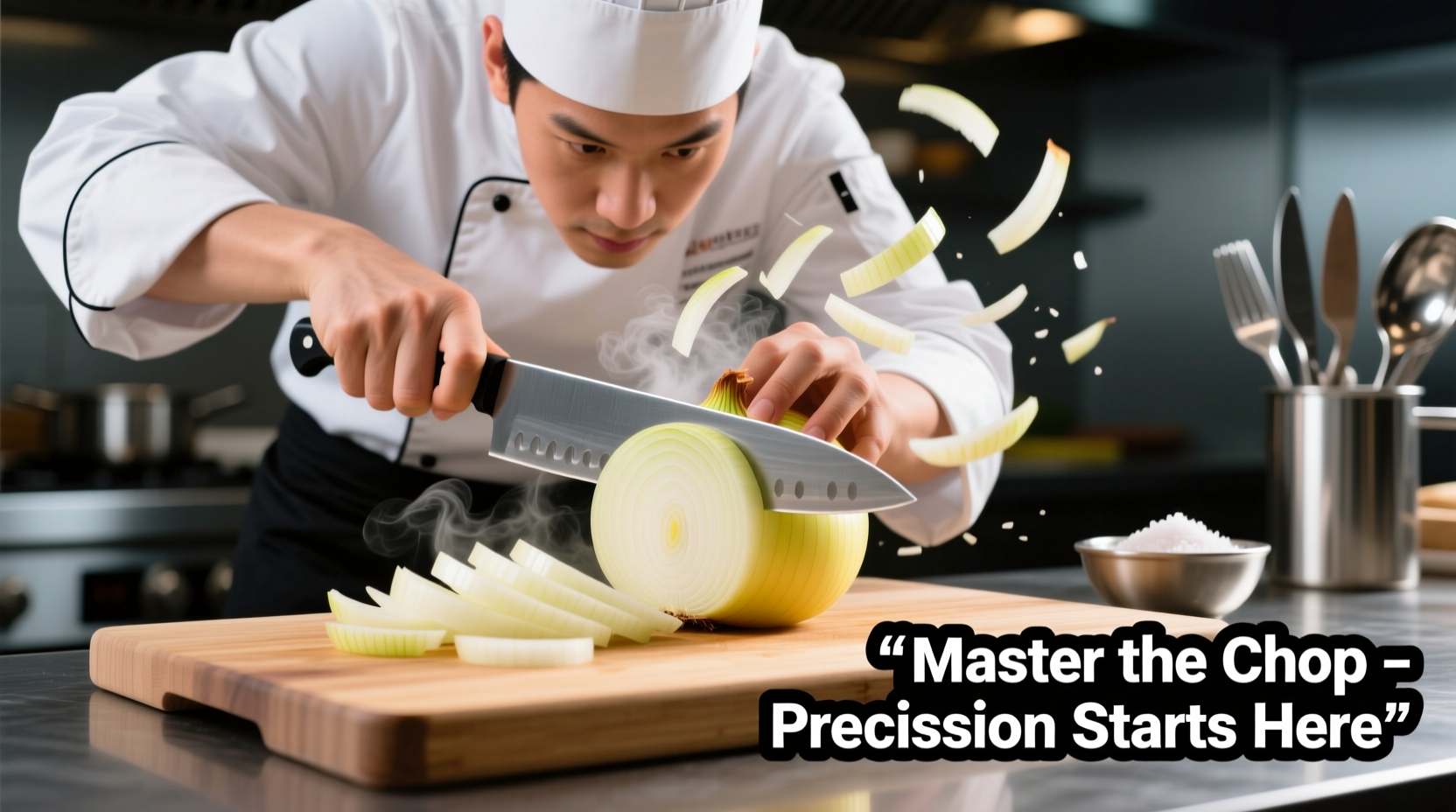Why Mastering Onion Chopping Matters
Onions are the culinary cornerstone across global cuisines, with research from the International Association of Culinary Professionals showing they form the flavor base for 85% of savory dishes. Whether crafting French onion soup or Mexican salsa, your chopping technique directly impacts texture, flavor release, and cooking time. Professional chefs consistently emphasize that how you prepare onions determines whether they enhance or overwhelm your dish.

The Science Behind Onion Preparation
When you cut an onion, you rupture cell walls, releasing enzymes that create sulfenic acid - the compound responsible for both that distinctive onion flavor and the tears that often accompany chopping. Understanding this biochemical process helps you work smarter:
- Chilling onions for 30 minutes before cutting reduces tear production by slowing enzyme activity by up to 60%, according to food science research from the University of California, Davis
- Using a sharp knife creates cleaner cuts with less cell damage, minimizing irritants while preserving texture
- Cutting near running water or under a vent helps disperse the volatile compounds that cause eye irritation
| Chopping Technique | Size | Best For | Flavor Release |
|---|---|---|---|
| Minced | 1/8 inch or smaller | Sauces, dressings, quick-cooking dishes | Fastest, most intense flavor |
| Finely Chopped | 1/4 inch | Stir-fries, omelets, salsas | Quick flavor development |
| Medium Dice | 1/2 inch | Stews, soups, roasts | Moderate, sustained flavor |
| Rough Chop | 3/4 inch or larger | Stocks, braises, slow cooking | Subtle, gradual flavor release |
Step-by-Step: Professional Onion Chopping Technique
Follow these steps used by professional chefs to achieve consistent results without tears:
- Preparation: Chill onions for 30 minutes, use a sharp chef's knife (8-10 inch), and work on a stable cutting board
- Trimming: Cut off root end first (leaving it intact until last preserves structure), then remove stem end
- Peeling: Remove outer skin and first translucent layer, which contains highest concentration of tear-inducing compounds
- Halving: Cut vertically through root end, creating two equal halves
- Creating Guides: Make horizontal cuts toward root end without cutting all the way through
- Vertical Slicing: Make vertical cuts from stem to root end at your desired width
- Final Chop: Slice across the onion to create uniform pieces, working toward root end
- Discarding: Cut away remaining root portion after chopping
When Size Matters: Culinary Applications
Different cuisines and dishes require specific onion preparations. Understanding these context boundaries prevents common cooking mistakes that home chefs make when chopping onions for different recipes:
- Mediterranean cooking: Medium dice works best for ratatouille and Greek salads where texture is important
- Mexican cuisine: Finely chopped onions (about 1/4 inch) provide the right texture for salsas and guacamole
- French techniques: For mirepoix (the flavor base of French cuisine), equal parts medium-diced onions, carrots, and celery create balanced flavor development
- Indian curries: Finely minced onions blend seamlessly into sauces while providing maximum flavor
- American barbecue: Rough chopped onions release flavor slowly during long smoking processes
Storage Solutions for Chopped Onions
Proper storage extends the life of your prepared onions while maintaining flavor quality. According to food safety guidelines from the USDA Food Safety and Inspection Service:
- Store in airtight container in refrigerator for 3-5 days
- Place paper towel in container to absorb excess moisture
- Never store at room temperature - bacteria growth accelerates rapidly
- For longer storage, freeze chopped onions in ice cube trays covered with water, then transfer to freezer bags (keeps 6 months)
- Do not store with potatoes - they release gases that accelerate spoilage
Avoiding Common Onion Chopping Mistakes
Even experienced home cooks make these errors that compromise flavor and safety when learning how to chop onions properly:
- Using a dull knife: Crushes cells rather than cutting cleanly, releasing more irritants and creating mushy texture
- Ignoring the root end: Removing it too early makes the onion fall apart during chopping
- Uneven sizing: Causes inconsistent cooking - smaller pieces burn while larger ones remain raw
- Washing after chopping: Dilutes flavor and creates sogginess - wash before chopping instead
- Storing in non-airtight containers: Allows odor transfer to other foods and accelerates spoilage
Onion Evolution: From Ancient Staple to Culinary Essential
Onions have been cultivated for over 5,000 years, with archaeological evidence showing their use in Bronze Age settlements. The timeline of onion preparation reveals how chopping techniques evolved alongside kitchen tools, providing historical context for modern onion chopping techniques:
- Prehistoric times: Onions were eaten raw or roasted whole - no chopping techniques existed
- Ancient Egypt (3000 BCE): Onions became sacred food; early chopping with stone tools created rough, uneven pieces
- Roman era: Development of metal knives allowed for more precise chopping, documented in Apicius' cookbook
- Medieval period: Onions were often minced extremely fine to preserve them in vinegar (early pickling)
- 19th century: Standardized chopping techniques emerged with professional culinary schools
- Modern era: Food processors revolutionized onion preparation but professional chefs still prefer hand-chopping for control
Maximizing Flavor in Your Dishes
The way you incorporate chopped onions into cooking significantly impacts final flavor. Food science research from the Culinary Institute of America shows optimal approaches for using chopped onions in recipes:
- Raw application: Finely chopped onions provide maximum pungency for salads and salsas - let them sit 10 minutes after chopping to develop full flavor
- Sautéing: Medium dice creates ideal surface area for caramelization without burning - start with cold oil to prevent sticking
- Slow cooking: Larger pieces maintain texture through long cooking times while still flavoring the dish
- Flavor layering: Add onions at different stages - some raw for brightness, some cooked for depth











 浙公网安备
33010002000092号
浙公网安备
33010002000092号 浙B2-20120091-4
浙B2-20120091-4